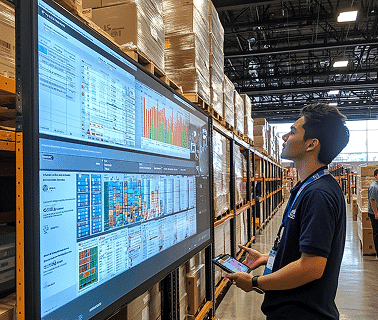Data analytics helps you better understand your business and its supply chain. It helps you make informed decisions, improve operational efficiency, and reduce risk. Supply chain managers use data analytics to track inventory levels, predict demand trends, and forecast production requirements. They use data analytics to determine how many products are shipped in the shortest possible time.
How does data analytics help supply chain management?
Data analytics in supply chain management is a powerful tool for businesses. It can help you:
- Reduce inventory costs
- Improve cargo shipment efficiency
- Achieve cross-functional cooperation
- Chalk a new S&OE (sales and operation planning) workflow
- Improve transport logistics
- Validate data
- Detect anomalies
- Benchmark operations
- Allow for mobile reporting
- Gain visibility into global logistics
- Analyze real-time route optimization
- Improve demand forecasts
Want to know the connection between SCM and the retail industry? Read our blog on the importance of SCM in the retail industry.
Data analytics in supply chain management
Data analytics is a powerful concept with the potential to revolutionize the supply chain management industry. It allows companies to gain a deeper understanding of their customers and products, leading to more effective marketing strategies, improved product development, and increased customer loyalty.
Here are some ways that data analytics can help supply chain managers:
1. Supply Chain Analytics Tools
Supply chain analytics is a great way to track, analyze, and understand the movement of goods through a supply chain. It can be used to identify problems in the process and make improvements. Additionally, you can use it as a supply chain analytics tool for comparing other companies’ strategies against your own.
Supply chain analytics is different from traditional business intelligence (BI) systems because it’s designed to look at data from multiple sources, including internal records, customer transactions, and third-party data such as market research reports or industry news articles.
Supply chain analytics can be used for many purposes, including:
- improving product quality by identifying issues with suppliers or manufacturing processes;
- reducing waste by understanding which parts of the process are most inefficient;
- aligning goals with business strategy by determining whether a particular business model will yield optimal results for your organization;
- determining how much money to spend on certain steps of your supply chain;
- helping you decide which suppliers are best suited for what needs they provide – suppose one supplier is willing to provide products at a lower cost but doesn’t have fast delivery times. The other supplier has vice versa properties. Then, paying for fast delivery would be a great decision.
The tools used for supply chain analytics include:
- SAP Supply Chain Analytics Software
- PeopleSoft Supply Chain Analytics
- JDA Supply Chain Analytics
- Manhattan Associates Visibility and Insight
- Ariba Analysis
- SAS Supply Chain Intelligence
- Cognos Supply Chain Performance Procurement Analytics
- Tableau Software Supply Chain
- TARGIT Business Intelligence & Analytics solution
- Kinaxis RapidResponse
2. Predictive Supply Chain Analytics
Predictive supply chain analytics is the process of analyzing data to predict future demand and supply, enabling companies to make more informed decisions and take pre-emptive action. Companies in many industries, including retail, manufacturing, healthcare, logistics, and finance, can use predictive supply chain analytics.
The key to predictive supply chain analytics is using machine learning algorithms to analyze historical data and predict future events. For example, a company may use predictive supply chain analytics to predict whether it will need more inventory for a particular product or service based on trends in sales patterns over time. The result would be an early warning system that allows them to adjust their inventory levels accordingly.
Want to know the relationship between supply chain management and operations management? Read our guide on SCM and operations management and how they go hand-in-hand.
3. Supply Chain Data Visualization
Supply chain data visualization uses various tools to display the flow of products and materials through a supply chain. This can be done through geographical and product flow diagrams.
A geographic flow diagram shows where products are shipped from, where they are stored, and where they are eventually shipped to. In contrast, a product flow diagram shows how many units of each product are being produced at any given time and how much material goes into each unit of that product. It also shows how much time it takes for each step to complete.
Supply chain data visualization can show how long it takes for products to reach their destination, how much inventory is left, where there are delays or problems in the flow of goods, or how much money is being lost due to poor processes or inefficient organization.
Supply chain data visualization presents data in graphs, flowcharts, Gantt charts, time series, and tables.
Want to know the best analytics tools in the market? Check out our detailed blog on essential business analytics tools for more information!
4. Big Data in Supply Chain Management
Big data describes a company’s growing amounts of collected, stored, and analyzed data. This data includes customer purchase histories, product performance statistics, and social media posts.
Big data in supply chain management is applied to product development and testing, product lifecycle management, demand forecasting, inventory management, pricing decisions, and promotions.
In general, big data can analyze patterns in large sets of information (such as historical trends or customer behavior) to improve your processes and make better decisions based on what you know about your customers’ preferences and behaviors.
Want to know more about marketing analytics? Check out our beginner’s guide for marketing analytics to get started!
Tabular representation of the supply chain management process
| Step | Process |
|---|---|
| Procurement | Secure the goods |
| Inventory | Maintain the goods |
| Manufacturing | Putting everything together |
| Quality Control | Check the work |
| Sales Coordination | Pitch the product |
| Distribution | Fulfill the orders |
| Logistics | Profit and analysis |
Conclusion
As the business world becomes more competitive, companies need to become more efficient with their supply chains. Companies that succeed in this area will be able to respond quickly to market changes and maintain profitability.
The supply chain management course at Online Manipal offers students the ability to learn about all aspects of the industry, including how companies manage the flow of goods from suppliers to consumers. Students will learn about supply chain management theories and best practices and how businesses can adapt their existing processes to meet new challenges.
Key takeaways:
- Data analytics allows companies to find ways to reduce costs, improve productivity, and increase revenue by using data-driven decision-making.
- Data analytics is a powerful tool for optimizing supply chain management processes. It can identify and quantify the effects of variables on various business processes, such as inventory management and production scheduling.
- Data analytics can help companies manage their supply chain more efficiently by identifying factors that affect performance and using them to make adjustments to improve efficiency.
Prepare for your next career milestone with us








